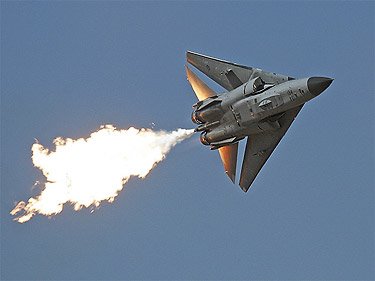Air Superiority
 We need a replacement by at least 2008-10. The F111 has served us well. "Peace thru Air Superiority" is vital for Australia's defence.
We need a replacement by at least 2008-10. The F111 has served us well. "Peace thru Air Superiority" is vital for Australia's defence.F-111 withdrawal leaves gap: ALP
April 17, 2006
EARLY retirement of the air force's F-111 combat aircraft would leave Australia's defences exposed, Labor said.
Senior RAAF officers and defence scientists reportedly were seeking to fast-track plans to buy long-range missiles and upgrade other war planes so the F-111s can be withdrawn.
They were due to be phased out in 2010, but defence sources told News Limited newspapers this could be brought forward to 2008.
RAAF chief Air Marshal Geoff Shepherd told a parliamentary inquiry three weeks ago the F-111 was a "very old aeroplane" which required a lot of servicing.
"We need to get out of the F-111 business," he said.
"The risks increase as time goes on, and we need to look at what we can do to mitigate those risks."
Plans to make the transition from F-111 to the new Joint Strike Fighter (JSF) will be presented to defence officials later this year, the inquiry was told.
But Labor's defence spokesman Robert McClelland said the early phase-out of the F-111s would affect Australia's defence capabilities.
"Even on best estimates we will not have an Australian combat-capable joint strike fighter until 2014," Mr McClelland said.
"Retirement of our F-111 strike aircraft in 2008 would leave Australia exposed to a regional air superiority gap of at least six years.
"Any gap in our air force's front line capability is unacceptable, but a six year gap would be reckless in the extreme."
The speculation comes as reports emerge of a potential cost blowout in Australia's plan to buy 100 JSFs, the replacement for the F-111 and F/A-18 aircraft, from the US.
Australia plans to spend around $16 billion on the aircraft – a fifth-generation jet fighter prized for its advanced stealth, sensor technologies and ground and air-attack capabilities.
But an audit by the US General Accounting Office has revised the cost of the program – which involves the US building 2400 aircraft for up to 16 countries – from $A351 billion to $A378 billion.
The costs are expected to flow on to Australia.
Comment was being sought from Defence Minister Brendan Nelson.


<< Home